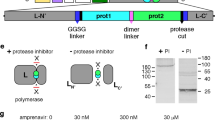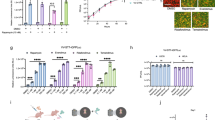Abstract
Vectors based on recombinant SV40 viruses (rSV40) are highly effective in delivering transgene expression driven by constitutive promoters. We tested here whether these vectors could be used with conditional promoters and promoters using RNA polymerase III transcription, with inhibition of HIV-1 by Tat activation response (TAR) decoys as a functional measure of effective transgene delivery and activity. TAR decoys inhibit HIV-1 Tat, a trans-activator of HIV-1 transcription. Tat acts early in the viral replicative cycle and is essential for efficient viral replication. We evaluated rSV40 gene delivery using two different inhibitors of Tat. One was a dual function polyTAR gene encoding 25 sequential TAR elements (TAR25), plus an antisense tat, driven either by HIV-1 long terminal repeat (HIV-LTR) as a conditional promoter, or by cytomegalovirus immediate–early promoter (CMV-IEP) as a constitutive promoter. The other inhibitor was a single TAR decoy, driven by the U6 small nuclear RNA promoter (U6-P). These decoys were delivered to unselected cells in two different human T lymphocyte lines and to unstimulated primary human peripheral blood mononuclear cells (pbmc). Gene delivery was confirmed by PCR, and expression by RT-PCR. By in situ hybridization analysis, >95% of cells were transduced. These transgene constructs protected all cell types tested from HIV-1, as measured by syncytia formation and p24 antigen release. Somewhat better inhibition of HIV-1 replication was achieved with HIV-1 long terminal repeat (HIV-1 LTR) as a conditional promoter than with the constitutive CMV-IEP. The U6-P was also very effective, driving a TAR1 transcript. Cell viability was not detectably affected by TAR decoy expression. Thus, rSV40 vectors effectively deliver HIV-1-inhibitory RNAs using either constitutive or conditional pol II promoters, or using a pol III promoter. The versatility of this gene delivery system may prove to be useful in anti-HIV-1 therapeutics.
This is a preview of subscription content, access via your institution
Access options
Subscribe to this journal
Receive 12 print issues and online access
$259.00 per year
only $21.58 per issue
Buy this article
- Purchase on Springer Link
- Instant access to full article PDF
Prices may be subject to local taxes which are calculated during checkout











Similar content being viewed by others
References
Strayer DS, Kondo R, Milano J, Duan LX . Use of SV40-based vectors to transduce foreign genes to normal human peripheral blood mononuclear cells Gene Therapy 1997 4: 219–225
Strayer DS . SV40 as an effective gene transfer vector in vitro J Biol Chem 1996 271: 24741–24746
Lisziewicz J et al. Inhibition of human immunodeficiency virus type 1 replication by regulated expression of a polymeric Tat activation response RNA decoy as a strategy for gene therapy in AIDS Proc Natl Acad Sci USA 1993 90: 8000–8004
Feinberg MB, Baltimore D, Frankel AD . The role of Tat in the human immunodeficiency virus life cycle indicates a primary effect on transcriptional elongation Proc Natl Acad Sci USA 1991 88: 4045–4049
Lisziewicz J et al. An autoregulated dual-function antitat gene for human immunodeficiency virus type 1 gene therapy J Virol 1995 69: 206–212
Lisziewicz J, Sun D, Lisziewicz A, Gallo RC . Antitat gene therapy: a candidate for late-stage AIDS patients Gene Therapy 1995 2: 218–222
Emerman M, Malim MH . HIV-1 regulatory/accessory genes: keys to unraveling viral and host cell biology Science 1998 280: 1880–1884
Goomer RS, Kunkel GR . The transcriptional start site for a human U6 small nuclear RNA gene is dictated by a compound promoter element consisting of the PSE and the TATA box Nucleic Acids Res 1992 20: 4903–4912
Kunkel GR, Pederson T . Upstream elements required for efficient transcription of a human U6 RNA gene resemble those of U1 and U2 genes even though a different polymerase is used Genes Dev 1988 2: 196–204
Bertrand E et al. The expression cassette determines the functional activity of ribozymes in mammalian cells by controlling their intracellular localization RNA 1997 3: 75–88
Good PD et al. Expression of small, therapeutic RNAs in human cell nuclei Gene Therapy 1997 4: 45–54
Sullenger BA, Gallardo HF, Ungers GE, Gilboa E . Overexpression of TAR sequence renders cells resistant to human immunodeficiency virus replication Cell 1990 63: 601–608
Saag MS et al. Extensive variation of human immunodeficiency virus type-1 in vivo Nature 1988 334: 440–444
BouHamdan M, Duan LX, Pomerantz RJ, Strayer DS . Inhibition of HIV-1 by an anti-integrase single-chain variable fragment (SFv): delivery by SV40 provides durable protection against HIV-1 and does not require selection Gene Therapy 1999 6: 660–666
Strayer DS . Effective gene transfer using viral vectors based on SV40. In: Kmiec EB (ed.) Methods in Molecular Biology: Gene Targeting Vector Protocols 133 Humana Press: New York 1999 61–74
Cory AH, Owens TC, Barltrop JA, Cory JG . Use of an aqueous soluble tetrazolium/formazan assay for cell growth assays in culture Cancer Commun 1991 3: 207
Kondo R, Feitelson MA, Strayer DS . Use of SV40 to immunize against hepatitis B surface antigen: implications for the use of SV40 for gene transduction and its use as an immunizing agent Gene Therapy 1998 5: 575–582
Strayer DS et al. Efficient gene transfer to hematopoietic progenitor cells using SV40-derived vectors Gene Therapy 2000 7: 886–895
Sauter BV et al. Gene transfer to the liver using a replication-deficient recombinant SV40 vector results in long-term amelioration of jaundice in Gunn rats Gastroenterology 2000 119: 1348–1357
Strayer DS . SV40-based gene transfer vectors: turning an adversary into a friend Curr Opin Mol Therapeut 2000 2: 570–578
Lisziewicz J, Rappaport J, Dhar R . Tat-regulated production of multimerized TAR RNA inhibits HIV-1 gene expression New Biol 1991 3: 82–89
Chang HK et al. Block of HIV-1 infection by a combination of antisense tat RNA and TAR decoys: a strategy for control of HIV-1 Gene Therapy 1994 1: 208–216
Chatterjee S, Johnson PR, Wong KK Jr . Dual-target inhibition of HIV-1 in vitro by means of an adeno-associated virus antisense vector Science 1992 258: 1485–1488
Kim YS, Risser R . TAR-independent transactivation of the murine cytomegalovirus major immediate-early promoter by the Tat protein J Virol 1993 67: 239–248
Robinson D, Elliott JF, Chang LJ . Retroviral vector with a CMV-IE/HIV-TAR hybrid LTR gives high basal expression levels and is up-regulated by HIV-1 Tat Gene Therapy 1995 2: 269–278
Rund D et al. Efficient transduction of human hematopoietic cells with the human multidrug resistance gene 1 via SV 40 pseudovirion Hum Gene Ther 1998 9: 649–657
Zern M et al. A novel SV40-based vector successfully transduces and expresses an alpha 1-antitrypsin ribozyme in a human hepatoma-derived cell line Gene Therapy 1999 6: 114–120
Strayer DS . Gene therapy using SV40-derived vectors: what does the future hold? J Cell Physiol 1999 181: 375–384
Yee C, Riddell SR, Greenberg PD . Prospects for adoptive T cell therapy Curr Opin Immunol 1997 9: 702–708
Greenberg PD, Riddell SR . Deficient cellular immunity-finding and fixing the defects Science 1999 285: 546–551
Strayer DS, Zern MA . Gene delivery to the liver using SV40-derived vectors Semin Liver Dis 1999 19: 71–81
Rosenberg BH, Deutsch JF, Ungers GE . Growth and purification of SV40 virus for biochemical studies J Virol Meth 1981 3: 167–176
Strayer DS et al. Titering replication-defective virus for use in gene transfer BioTechniques 1997 22: 447–450
Maniatis T . Molecular Cloning: A Laboratory Manual Cold Spring Harbor Laboratory Press: Cold Spring Harbor 1982
CellTiter 96 Non-Radioactive Cell Proliferation Assay Technical Bulletin, TB112, Promega Corporation
Acknowledgements
These studies were supported by NIH grants RR13156, AI41399, MH58526 and RR00168. The advice of Drs J Roy Chowdhury, Ling-Xun Duan, Paul Hyman, Martyn White and Mark A Zern was helpful in planning and executing some of the studies described here. The technical help of Ms Maria E Lamothe is gratefully acknowledged. We thank Dr GR Kunkel for the kind gift of the U6 promoter construct.
Author information
Authors and Affiliations
Rights and permissions
About this article
Cite this article
Jayan, G., Cordelier, P., Patel, C. et al. SV40-derived vectors provide effective transgene expression and inhibition of HIV-1 using constitutive, conditional,and pol III promoters. Gene Ther 8, 1033–1042 (2001). https://doi.org/10.1038/sj.gt.3301481
Received:
Accepted:
Published:
Issue Date:
DOI: https://doi.org/10.1038/sj.gt.3301481
Keywords
This article is cited by
-
HIV-1 proprotein processing as a target for gene therapy
Gene Therapy (2003)
-
Erythrocyte-mediated delivery of drugs, peptides and modified oligonucleotides
Gene Therapy (2002)



